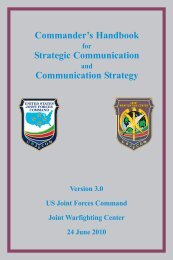A Leader's Guide to Trauma in the Unit - US Army War College
A Leader's Guide to Trauma in the Unit - US Army War College
A Leader's Guide to Trauma in the Unit - US Army War College
You also want an ePaper? Increase the reach of your titles
YUMPU automatically turns print PDFs into web optimized ePapers that Google loves.
<strong>Army</strong> <strong>War</strong> <strong>College</strong> Spouses’ Project<br />
Why We Wrote This Book<br />
“Tell me how much you know of <strong>the</strong> suffer<strong>in</strong>gs of your fellow men and I will tell you how<br />
much you have loved <strong>the</strong>m.” -- Helmut Thieliecke<br />
A sudden death…a serious <strong>in</strong>jury or illness…a soldier miss<strong>in</strong>g <strong>in</strong> action — when this<br />
happens <strong>to</strong> anyone <strong>in</strong> our units, our hearts s<strong>to</strong>p. <strong>Trauma</strong> — hard <strong>to</strong> talk about, hard <strong>to</strong><br />
th<strong>in</strong>k about and hard <strong>to</strong> write about. Why, <strong>the</strong>n, did this group of <strong>Army</strong>, Mar<strong>in</strong>e and Air<br />
Force spouses want <strong>to</strong> do this particular project?<br />
Each of us work<strong>in</strong>g on this project has been <strong>to</strong>uched personally by trauma <strong>in</strong> some way.<br />
This compilation represents <strong>the</strong> comb<strong>in</strong>ed and varied personal experiences we have had.<br />
We have emphasized those experiences we had while our spouses were <strong>in</strong> command. The<br />
“Death of a Soldier” and “Special Circumstances” chapters draw from our experiences<br />
dur<strong>in</strong>g <strong>the</strong> military conflicts/<strong>in</strong>terventions <strong>in</strong> Panama, Desert S<strong>to</strong>rm, Somalia, Operation<br />
Endur<strong>in</strong>g Freedom, Operation Iraqi Freedom and dur<strong>in</strong>g tra<strong>in</strong><strong>in</strong>g accidents. <strong>Trauma</strong> can<br />
happen at any time — dur<strong>in</strong>g tra<strong>in</strong><strong>in</strong>g, <strong>in</strong> war, at home or on <strong>the</strong> way <strong>to</strong> work. As<br />
company and battalion commander spouses, we dealt with deaths and <strong>in</strong>juries of soldiers<br />
<strong>in</strong> combat and tra<strong>in</strong><strong>in</strong>g, term<strong>in</strong>al illnesses of both active-duty personnel and spouses, and<br />
<strong>the</strong> death of a child. In most cases we learned through <strong>the</strong> “school of hard knocks.”<br />
We all know that, with <strong>the</strong> current level of deployments, <strong>the</strong> chances of trauma <strong>in</strong> <strong>the</strong> unit<br />
are greater than ever. Though no two traumas are alike, we found <strong>in</strong> our experiences that<br />
<strong>the</strong> better prepared and knowledgeable we were, <strong>the</strong> better we were able <strong>to</strong> assist those<br />
directly <strong>in</strong>volved.<br />
This project provides a guide for you <strong>to</strong> access <strong>in</strong> case of a trauma <strong>in</strong> your unit. In our<br />
research, we found numerous references <strong>to</strong> <strong>the</strong> <strong>to</strong>pic, but we noted a lack of a s<strong>in</strong>gle<br />
comprehensive resource that looked at <strong>the</strong> issue <strong>in</strong> depth. Hopefully this book will serve<br />
that purpose for you. We address <strong>to</strong>pics that have been important and helpful <strong>to</strong> us —<br />
preparation, <strong>the</strong> military role, and practical ways <strong>to</strong> help. It has been our experience that<br />
<strong>the</strong> more familiar we have been with <strong>the</strong> active-duty role, <strong>the</strong> easier it has been for us <strong>to</strong><br />
focus on <strong>the</strong> “heart” side of help<strong>in</strong>g <strong>in</strong> times of trauma and crisis.<br />
We encourage you <strong>to</strong> read this book cover <strong>to</strong> cover so that you will be familiar with its<br />
contents, layout and design before an <strong>in</strong>cident occurs. However, we have designed each<br />
chapter <strong>to</strong> stand on its own so that if you experience a trauma <strong>in</strong> your unit you can access<br />
just <strong>the</strong> <strong>in</strong>formation relevant <strong>to</strong> your situation. We have also provided an Appendix<br />
section and a list of resources that should give you even more <strong>in</strong>formation. This<br />
publication is by no means an exhaustive resource; we hope that you will add <strong>to</strong> it and<br />
tailor it <strong>to</strong> your specific needs.<br />
________________________________________________________________________<br />
iii<br />
A Leader’s <strong>Guide</strong> <strong>to</strong> <strong>Trauma</strong> <strong>in</strong> <strong>the</strong> <strong>Unit</strong> April 2004





